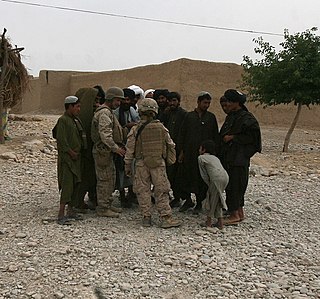
Military intelligence is a military discipline that uses information collection and analysis approaches to provide guidance and direction to assist commanders in their decisions. This aim is achieved by providing an assessment of data from a range of sources, directed towards the commanders' mission requirements or responding to questions as part of operational or campaign planning. To provide an analysis, the commander's information requirements are first identified, which are then incorporated into intelligence collection, analysis, and dissemination.
Intelligence assessment, or simply intel, is the development of behavior forecasts or recommended courses of action to the leadership of an organisation, based on wide ranges of available overt and covert information (intelligence). Assessments develop in response to leadership declaration requirements to inform decision-making. Assessment may be executed on behalf of a state, military or commercial organisation with ranges of information sources available to each.

The Bureau of Intelligence and Research (INR) is an intelligence agency in the United States Department of State. Its central mission is to provide all-source intelligence and analysis in support of U.S. diplomacy and foreign policy. INR is the oldest civilian element of the U.S. Intelligence Community and among the smallest, with roughly 300 personnel. Though lacking the resources and technology of other U.S. intelligence agencies, it is "one of the most highly regarded" for the quality of its work.

Geoinformatics is a scientific field primarily within the domains of Computer Science and technical geography. It focuses on the programming of applications, spatial data structures, and the analysis of objects and space-time phenomena related to the surface and underneath of Earth and other celestial bodies. The field develops software and web services to model and analyse spatial data, serving the needs of geosciences and related scientific and engineering disciplines. The term is often used interchangeably with Geomatics, although the two have distinct focuses; Geomatics emphasizes acquiring spatial knowledge and leveraging information systems, not their development. At least one publication has claimed the discipline is pure computer science outside the realm of geography.
The United States government classification system is established under Executive Order 13526, the latest in a long series of executive orders on the topic of classified information beginning in 1951. Issued by President Barack Obama in 2009, Executive Order 13526 replaced earlier executive orders on the topic and modified the regulations codified to 32 C.F.R. 2001. It lays out the system of classification, declassification, and handling of national security information generated by the U.S. government and its employees and contractors, as well as information received from other governments.
Intelligence analysis is the application of individual and collective cognitive methods to weigh data and test hypotheses within a secret socio-cultural context. The descriptions are drawn from what may only be available in the form of deliberately deceptive information; the analyst must correlate the similarities among deceptions and extract a common truth. Although its practice is found in its purest form inside national intelligence agencies, its methods are also applicable in fields such as business intelligence or competitive intelligence.

The under secretary of defense for intelligence and security or USD(I&S) is a high-ranking civilian position in the Office of the Secretary of Defense (OSD) within the U.S. Department of Defense (DoD) that acts as the principal civilian advisor and deputy to the secretary of defense (SecDef) and deputy secretary of defense (DepSecDef) on matters relating to military intelligence and security. The under secretary is appointed as a civilian by the president and confirmed by the Senate to serve at the pleasure of the president.
Commercial intelligence is a form of open-source intelligence practiced by diverse international and local businesses. Business Intelligence is a misnomer for data mining and enterprise dashboards that present useful patterns or distillations of internal information to the executive.

The United States Army Intelligence and Security Command (INSCOM) is a direct reporting unit that conducts intelligence, security, and information operations for United States Army commanders, partners in the Intelligence Community, and national decision-makers. INSCOM is headquartered at Fort Belvoir, Virginia.
Policy studies is a subdiscipline of political science that includes the analysis of the process of policymaking and the contents of policy. Policy analysis includes substantive area research, program evaluation and impact studies, and policy design. It "involves systematically studying the nature, causes, and effects of alternative public policies, with particular emphasis on determining the policies that will achieve given goals." It emerged in the United States in the 1960s and 1970s.
Most federal regulatory agencies in the United States government must comply with specific peer review requirements before the agencies publicly disseminate certain scientific information. These requirements were published in a Peer Review Bulletin issued by the White House Office of Management and Budget (OMB), which establishes "government-wide standards concerning when peer review is required and, if required, what type of peer review processes are appropriate."
Intelligence collection management is the process of managing and organizing the collection of intelligence from various sources. The collection department of an intelligence organization may attempt basic validation of what it collects, but is not supposed to analyze its significance. There is debate in U.S. intelligence community on the difference between validation and analysis, where the National Security Agency may try to interpret information when such interpretation is the job of another agency.
Intelligence cycle management refers to the overall activity of guiding the intelligence cycle, which is a set of processes used to provide decision-useful information (intelligence) to leaders. The cycle consists of several processes, including planning and direction, collection, processing and exploitation, analysis and production, and dissemination and integration. The related field of counterintelligence is tasked with impeding the intelligence efforts of others. Intelligence organizations are not infallible but, when properly managed and tasked, can be among the most valuable tools of management and government.
Intelligence dissemination management is a maxim of intelligence arguing that intelligence agencies advise policymakers instead of shaping policy. Due to the necessity of quick decision-making in periods of crisis, intelligence analysts may suggest possible actions, including a prediction of the consequences of each decision. Intelligence consumers and providers still struggle with the balance of what drives information flow. Dissemination is the part of the intelligence cycle that delivers products to consumers, and intelligence dissemination management refers to the process that encompasses organizing the dissemination of the finished intelligence.
Intelligence requirements (IR) are a ranking of topics or issues by priority which are used to inform the allocation of resources for intelligence collection. They define the intended end product, prescribe required resources, and identify gaps in capabilities for collection management. Once an intelligence requirement is identified, it is the responsibility of the decision maker's intelligence staff or if requested, supporting intelligence organization(s), to collect and disseminate the required information. The identification of intelligence requirements and the collection and dissemination of the required information are parts of the intelligence cycle. In the United States Intelligence Community (IC), requirements must comply with the National Intelligence Priorities Framework (NIPF).
Failure in the intelligence cycle or intelligence failure, is the outcome of the inadequacies within the intelligence cycle. The intelligence cycle itself consists of six steps that are constantly in motion: requirements, collection, processing and exploitation, analysis and production, dissemination and consumption, and feedback.
The target-centric approach to intelligence is a method of intelligence analysis that Robert M. Clark introduced in his book "Intelligence Analysis: A Target-Centric Approach" in 2003 to offer an alternative methodology to the traditional intelligence cycle. Its goal is to redefine the intelligence process in such a way that all of the parts of the intelligence cycle come together as a network. It is a collaborative process where collectors, analysts and customers are integral, and information does not always flow linearly.
An intelligence collection plan (ICP) is the systematic process used by most modern armed forces and intelligence services to meet intelligence requirements through the tasking of all available resources to gather and provide pertinent information within a required time limit. Creating a collection plan is part of the intelligence cycle.
Geographic information systems (GIS) play a constantly evolving role in geospatial intelligence (GEOINT) and United States national security. These technologies allow a user to efficiently manage, analyze, and produce geospatial data, to combine GEOINT with other forms of intelligence collection, and to perform highly developed analysis and visual production of geospatial data. Therefore, GIS produces up-to-date and more reliable GEOINT to reduce uncertainty for a decisionmaker. Since GIS programs are Web-enabled, a user can constantly work with a decision maker to solve their GEOINT and national security related problems from anywhere in the world. There are many types of GIS software used in GEOINT and national security, such as Google Earth, ERDAS IMAGINE, GeoNetwork opensource, and Esri ArcGIS.

TASC, Inc., formerly known as The Analytic Sciences Corporation, is an American private defense contractor based outside Washington, D.C., in Chantilly, Virginia. Northrop Grumman owned TASC from 2001 to 2009, when it sold the unit to comply with new government conflict of interest rules.








